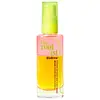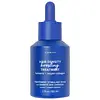What's inside
What's inside
 Key Ingredients
Key Ingredients

 Benefits
Benefits

 Concerns
Concerns

 Ingredients Side-by-side
Ingredients Side-by-side

Lactobacillus
Skin ConditioningC13-15 Alkane
SolventDioctyldodecyl Dodecanedioate
EmollientEthylhexyl Pelargonate
EmollientWater
Skin ConditioningPentylene Glycol
Skin ConditioningButylene Glycol
Humectant1,2-Hexanediol
Skin ConditioningHydrolyzed Yeast Protein
Skin ConditioningTetrahexyldecyl Ascorbate
AntioxidantTocopheryl Acetate
AntioxidantSphingomonas Ferment Extract
Skin ConditioningInulin
Skin ConditioningHydroxypropylammonium Gluconate
HumectantAlpha-Glucan Oligosaccharide
CleansingSaccharide Isomerate
HumectantHydroxypropylgluconamide
HumectantSodium Acetylated Hyaluronate
HumectantSodium Hyaluronate
HumectantSodium Hyaluronate Crosspolymer
HumectantHydrolyzed Sodium Hyaluronate
Skin ConditioningCaesalpinia Spinosa Fruit Pod Extract
Helianthus Annuus Sprout Extract
Skin ConditioningMoringa Oleifera Seed Oil
EmollientMelia Azadirachta Extract
Skin ConditioningCoccinia Indica Fruit Extract
Skin ConditioningEclipta Prostrata Extract
Skin ConditioningSodium Citrate
BufferingHeptyl Glucoside
Glycerin
HumectantMaltodextrin
AbsorbentPolyglyceryl-10 Laurate
Skin ConditioningSodium Phytate
Sodium Benzoate
MaskingPotassium Sorbate
PreservativeGlycolic Acid
BufferingCitric Acid
BufferingTartaric Acid
BufferingBenzyl Alcohol
PerfumingEthylhexylglycerin
Skin ConditioningCitral
PerfumingCitronellol
PerfumingGeraniol
PerfumingHydroxycitronellal
PerfumingLimonene
PerfumingLinalool
PerfumingParfum
MaskingLactobacillus, C13-15 Alkane, Dioctyldodecyl Dodecanedioate, Ethylhexyl Pelargonate, Water, Pentylene Glycol, Butylene Glycol, 1,2-Hexanediol, Hydrolyzed Yeast Protein, Tetrahexyldecyl Ascorbate, Tocopheryl Acetate, Sphingomonas Ferment Extract, Inulin, Hydroxypropylammonium Gluconate, Alpha-Glucan Oligosaccharide, Saccharide Isomerate, Hydroxypropylgluconamide, Sodium Acetylated Hyaluronate, Sodium Hyaluronate, Sodium Hyaluronate Crosspolymer, Hydrolyzed Sodium Hyaluronate, Caesalpinia Spinosa Fruit Pod Extract, Helianthus Annuus Sprout Extract, Moringa Oleifera Seed Oil, Melia Azadirachta Extract, Coccinia Indica Fruit Extract, Eclipta Prostrata Extract, Sodium Citrate, Heptyl Glucoside, Glycerin, Maltodextrin, Polyglyceryl-10 Laurate, Sodium Phytate, Sodium Benzoate, Potassium Sorbate, Glycolic Acid, Citric Acid, Tartaric Acid, Benzyl Alcohol, Ethylhexylglycerin, Citral, Citronellol, Geraniol, Hydroxycitronellal, Limonene, Linalool, Parfum
Water
Skin ConditioningPropanediol
SolventGlycerin
HumectantCurcuma Longa Root Extract
MaskingWithania Somnifera Root Extract
Skin ConditioningSr-Hydrozoan Polypeptide-1
HumectantBacopa Monnieri Extract
Skin ConditioningCamellia Sinensis Leaf Extract
AntimicrobialZingiber Officinale Root Extract
MaskingLarix Europaea Wood Extract
HumectantBiotin
AntiseborrhoeicSodium Hyaluronate
HumectantZinc Chloride
AntimicrobialAscorbic Acid
AntioxidantArginine
MaskingGlycine
BufferingButylene Glycol
HumectantHydroxyethylcellulose
Emulsion StabilisingPentylene Glycol
Skin ConditioningXanthan Gum
EmulsifyingSodium Metabisulfite
AntioxidantPhytic Acid
Tetrasodium Glutamate Diacetate
Potassium Sorbate
PreservativeSodium Hydroxide
BufferingCaprylyl Glycol
EmollientEthylhexylglycerin
Skin ConditioningCitric Acid
BufferingPhenoxyethanol
PreservativeParfum
MaskingCI 77491
Cosmetic ColorantCI 77492
Cosmetic ColorantBenzyl Salicylate
PerfumingCitronellol
PerfumingHexyl Cinnamal
PerfumingLimonene
PerfumingWater, Propanediol, Glycerin, Curcuma Longa Root Extract, Withania Somnifera Root Extract, Sr-Hydrozoan Polypeptide-1, Bacopa Monnieri Extract, Camellia Sinensis Leaf Extract, Zingiber Officinale Root Extract, Larix Europaea Wood Extract, Biotin, Sodium Hyaluronate, Zinc Chloride, Ascorbic Acid, Arginine, Glycine, Butylene Glycol, Hydroxyethylcellulose, Pentylene Glycol, Xanthan Gum, Sodium Metabisulfite, Phytic Acid, Tetrasodium Glutamate Diacetate, Potassium Sorbate, Sodium Hydroxide, Caprylyl Glycol, Ethylhexylglycerin, Citric Acid, Phenoxyethanol, Parfum, CI 77491, CI 77492, Benzyl Salicylate, Citronellol, Hexyl Cinnamal, Limonene
Alternatives
Ingredients Explained
These ingredients are found in both products.
Ingredients higher up in an ingredient list are typically present in a larger amount.
Butylene Glycol (or BG) is used within cosmetic products for a few different reasons:
Overall, Butylene Glycol is a safe and well-rounded ingredient that works well with other ingredients.
Though this ingredient works well with most skin types, some people with sensitive skin may experience a reaction such as allergic rashes, closed comedones, or itchiness.
Learn more about Butylene GlycolCitric Acid is an alpha hydroxy acid (AHA) naturally found in citrus fruits like oranges, lemons, and limes.
Like other AHAs, citric acid can exfoliate skin by breaking down the bonds that hold dead skin cells together. This helps reveal smoother and brighter skin underneath.
However, this exfoliating effect only happens at high concentrations (20%) which can be hard to find in cosmetic products.
Due to this, citric acid is usually included in small amounts as a pH adjuster. This helps keep products slightly more acidic and compatible with skin's natural pH.
In skincare formulas, citric acid can:
While it can provide some skin benefits, research shows lactic acid and glycolic acid are generally more effective and less irritating exfoliants.
Most citric acid used in skincare today is made by fermenting sugars (usually from molasses). This synthetic version is identical to the natural citrus form but easier to stabilize and use in formulations.
Read more about some other popular AHA's here:
Learn more about Citric AcidCitronellol is used to add fragrance/parfum to a product. It is often derived from plants such as roses. In fact, it can be found in many essential oils including geranium, lavender, neroli, and more. The scent of Citronellol is often described as "fresh, grassy, and citrus-like".
Since the Citronellol molecule is already unstable, Citronellol becomes irritating on the skin when exposed to air.
Citronellol is a modified terpene. Terpenes are unsaturated hydrocarbons found in plants. They make up the primary part of essential oils.
Citronellol is not able to be absorbed into deeper layers of the skin. It has low permeability,
Citronellol is also a natural insect repellent.
Learn more about CitronellolEthylhexylglycerin (we can't pronounce this either) is commonly used as a preservative and skin softener. It is derived from glyceryl.
You might see Ethylhexylglycerin often paired with other preservatives such as phenoxyethanol. Ethylhexylglycerin has been found to increase the effectiveness of these other preservatives.
Glycerin is already naturally found in your skin. It helps moisturize and protect your skin.
A study from 2016 found glycerin to be more effective as a humectant than AHAs and hyaluronic acid.
As a humectant, it helps the skin stay hydrated by pulling moisture to your skin. The low molecular weight of glycerin allows it to pull moisture into the deeper layers of your skin.
Hydrated skin improves your skin barrier; Your skin barrier helps protect against irritants and bacteria.
Glycerin has also been found to have antimicrobial and antiviral properties. Due to these properties, glycerin is often used in wound and burn treatments.
In cosmetics, glycerin is usually derived from plants such as soybean or palm. However, it can also be sourced from animals, such as tallow or animal fat.
This ingredient is organic, colorless, odorless, and non-toxic.
Glycerin is the name for this ingredient in American English. British English uses Glycerol/Glycerine.
Learn more about GlycerinLimonene is a fragrance that adds scent and taste to a formulation.
It's found in the peel oil of citrus fruits and other plants such as lavender and eucalyptus. The scent of limonene is generally described as "sweet citrus".
Limonene acts as an antioxidant, meaning it helps neutralize free radicals.
When exposed to air, oxidized limonene may sensitize the skin. Because of this, limonene is often avoided by people with sensitive skin.
The term 'fragrance' is not regulated in many countries. In many cases, it is up to the brand to define this term. For instance, many brands choose to label themselves as "fragrance-free" because they are not using synthetic fragrances. However, their products may still contain ingredients such as essential oils that are considered a fragrance.
Learn more about LimoneneParfum is a catch-all term for an ingredient or more that is used to give a scent to products.
Also called "fragrance", this ingredient can be a blend of hundreds of chemicals or plant oils. This means every product with "fragrance" or "parfum" in the ingredients list is a different mixture.
For instance, Habanolide is a proprietary trade name for a specific aroma chemical. When used as a fragrance ingredient in cosmetics, most aroma chemicals fall under the broad labeling category of “FRAGRANCE” or “PARFUM” according to EU and US regulations.
The term 'parfum' or 'fragrance' is not regulated in many countries. In many cases, it is up to the brand to define this term.
For instance, many brands choose to label themselves as "fragrance-free" because they are not using synthetic fragrances. However, their products may still contain ingredients such as essential oils that are considered a fragrance by INCI standards.
One example is Calendula flower extract. Calendula is an essential oil that still imparts a scent or 'fragrance'.
Depending on the blend, the ingredients in the mixture can cause allergies and sensitivities on the skin. Some ingredients that are known EU allergens include linalool and citronellol.
Parfum can also be used to mask or cover an unpleasant scent.
The bottom line is: not all fragrances/parfum/ingredients are created equally. If you are worried about fragrances, we recommend taking a closer look at an ingredient. And of course, we always recommend speaking with a professional.
Learn more about ParfumPentylene glycol is typically used within a product to thicken it. It also adds a smooth, soft, and moisturizing feel to the product. It is naturally found in plants such as sugar beets.
The hydrophilic trait of Pentylene Glycol makes it a humectant. As a humectant, Pentylene Glycol helps draw moisture from the air to your skin. This can help keep your skin hydrated.
This property also makes Pentylene Glycol a great texture enhancer. It can also help thicken or stabilize a product.
Pentylene Glycol also acts as a mild preservative and helps to keep a product microbe-free.
Some people may experience mild eye and skin irritation from Pentylene Glycol. We always recommend speaking with a professional about using this ingredient in your routine.
Pentylene Glycol has a low molecular weight and is part of the 1,2-glycol family.
Learn more about Pentylene GlycolPotassium Sorbate is a preservative used to prevent yeast and mold in products. It is commonly found in both cosmetic and food products.
This ingredient comes from potassium salt derived from sorbic acid. Sorbic acid is a natural antibiotic and effective against fungus.
Both potassium sorbate and sorbic acid can be found in baked goods, cheeses, dried meats, dried fruit, ice cream, pickles, wine, yogurt, and more.
You'll often find this ingredient used with other preservatives.
Learn more about Potassium SorbateSodium Hyaluronate is hyaluronic acid's salt form. It is commonly derived from the sodium salt of hyaluronic acid.
Like hyaluronic acid, it is great at holding water and acts as a humectant. This makes it a great skin hydrating ingredient.
Sodium Hyaluronate is naturally occurring in our bodies and is mostly found in eye fluid and joints.
These are some other common types of Hyaluronic Acid:
Learn more about Sodium HyaluronateWater. It's the most common cosmetic ingredient of all. You'll usually see it at the top of ingredient lists, meaning that it makes up the largest part of the product.
So why is it so popular? Water most often acts as a solvent - this means that it helps dissolve other ingredients into the formulation.
You'll also recognize water as that liquid we all need to stay alive. If you see this, drink a glass of water. Stay hydrated!
Learn more about Water